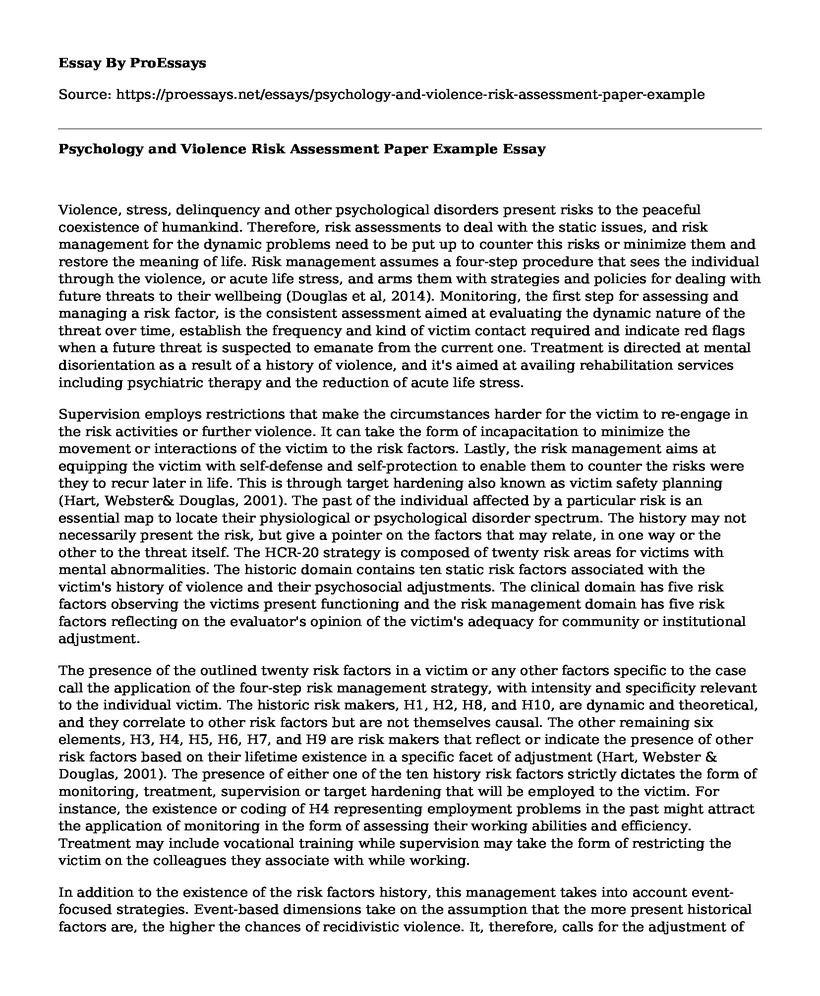Violence, stress, delinquency and other psychological disorders present risks to the peaceful coexistence of humankind. Therefore, risk assessments to deal with the static issues, and risk management for the dynamic problems need to be put up to counter this risks or minimize them and restore the meaning of life. Risk management assumes a four-step procedure that sees the individual through the violence, or acute life stress, and arms them with strategies and policies for dealing with future threats to their wellbeing (Douglas et al, 2014). Monitoring, the first step for assessing and managing a risk factor, is the consistent assessment aimed at evaluating the dynamic nature of the threat over time, establish the frequency and kind of victim contact required and indicate red flags when a future threat is suspected to emanate from the current one. Treatment is directed at mental disorientation as a result of a history of violence, and it's aimed at availing rehabilitation services including psychiatric therapy and the reduction of acute life stress.
Supervision employs restrictions that make the circumstances harder for the victim to re-engage in the risk activities or further violence. It can take the form of incapacitation to minimize the movement or interactions of the victim to the risk factors. Lastly, the risk management aims at equipping the victim with self-defense and self-protection to enable them to counter the risks were they to recur later in life. This is through target hardening also known as victim safety planning (Hart, Webster& Douglas, 2001). The past of the individual affected by a particular risk is an essential map to locate their physiological or psychological disorder spectrum. The history may not necessarily present the risk, but give a pointer on the factors that may relate, in one way or the other to the threat itself. The HCR-20 strategy is composed of twenty risk areas for victims with mental abnormalities. The historic domain contains ten static risk factors associated with the victim's history of violence and their psychosocial adjustments. The clinical domain has five risk factors observing the victims present functioning and the risk management domain has five risk factors reflecting on the evaluator's opinion of the victim's adequacy for community or institutional adjustment.
The presence of the outlined twenty risk factors in a victim or any other factors specific to the case call the application of the four-step risk management strategy, with intensity and specificity relevant to the individual victim. The historic risk makers, H1, H2, H8, and H10, are dynamic and theoretical, and they correlate to other risk factors but are not themselves causal. The other remaining six elements, H3, H4, H5, H6, H7, and H9 are risk makers that reflect or indicate the presence of other risk factors based on their lifetime existence in a specific facet of adjustment (Hart, Webster & Douglas, 2001). The presence of either one of the ten history risk factors strictly dictates the form of monitoring, treatment, supervision or target hardening that will be employed to the victim. For instance, the existence or coding of H4 representing employment problems in the past might attract the application of monitoring in the form of assessing their working abilities and efficiency. Treatment may include vocational training while supervision may take the form of restricting the victim on the colleagues they associate with while working.
In addition to the existence of the risk factors history, this management takes into account event-focused strategies. Event-based dimensions take on the assumption that the more present historical factors are, the higher the chances of recidivistic violence. It, therefore, calls for the adjustment of the strategies, and allow for the changes in the types of services offered rather than the intensity of these services. The past is as influential as the future, and for risk factors to be countered at the root level, the priors must be fixed to prevent future repercussions.
References
Douglas K.S., Hart S.D., Henrik B., Guy L.S., & Wilson C.M. (2014). Historical-Clinical-Risk Management-20, Version 3 (HCR-20V3. International Journal of Forensic Mental Health. Vol.13 (2). Pp.93-102.
Hart D.S., Webster D.C., & Douglas K.S. (2001). Risk management using the HCR-20. A general overview is focusing on historical factors. University of South Florida.
Cite this page
Psychology and Violence Risk Assessment Paper Example. (2022, Jun 19). Retrieved from https://proessays.net/essays/psychology-and-violence-risk-assessment-paper-example
If you are the original author of this essay and no longer wish to have it published on the ProEssays website, please click below to request its removal:
- Hanna Anderson Case Study
- Essay Sample on Differences Between the South and North in the Period From 1830-To-1860
- Distracted Driving in Florida State Essay
- Essay Sample on IKEA's Culture: Its Origin & Key Drivers
- Essay on College Experiences Impact Learning Inequality: African-Americans vs Whites vs Asians
- Essay Sample on Teen Drinking and Driving: A Deadly Combination
- Capitalism Versus Communism: The United States Versus the Soviet Union in the Cold War Years







